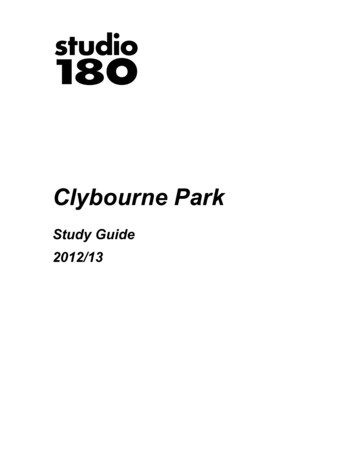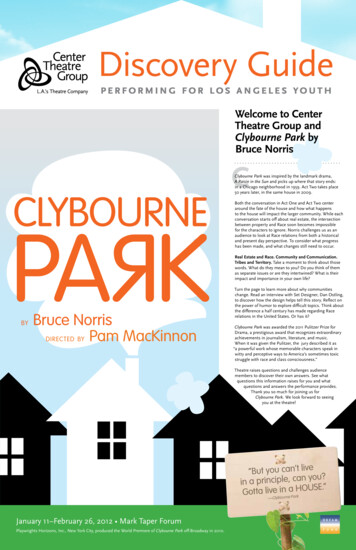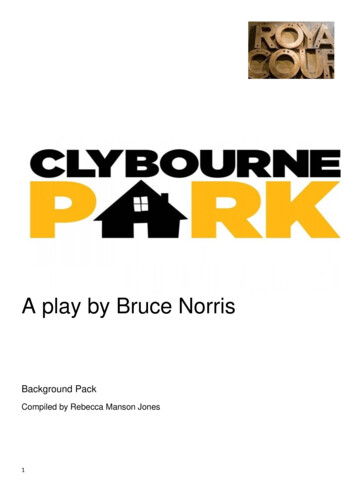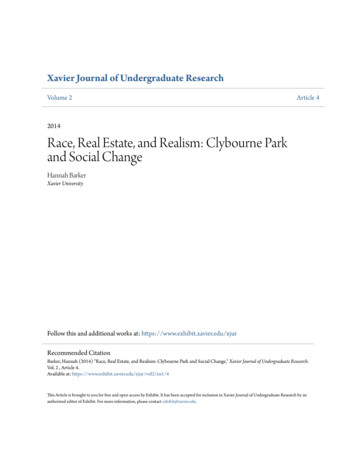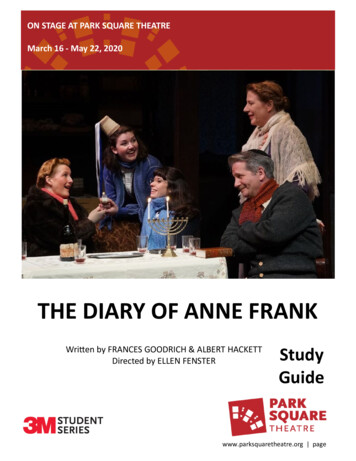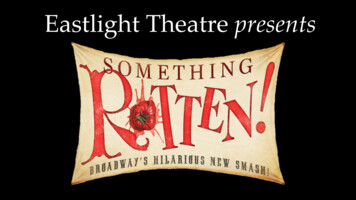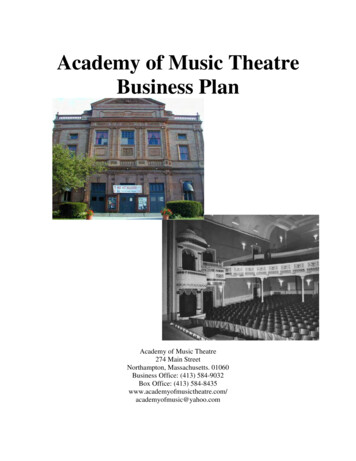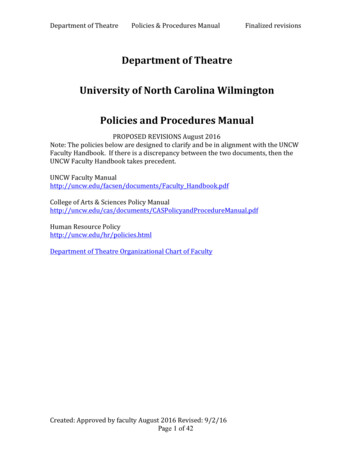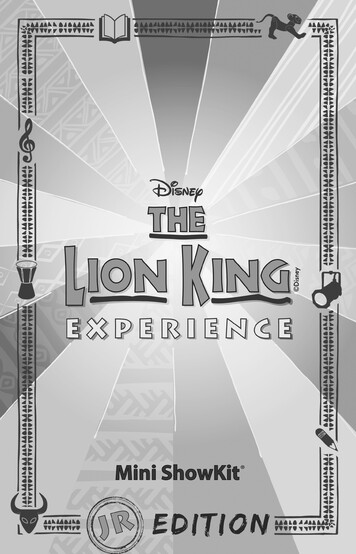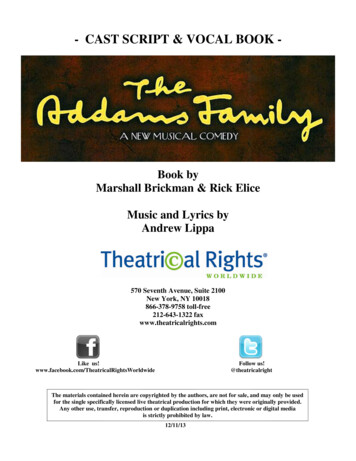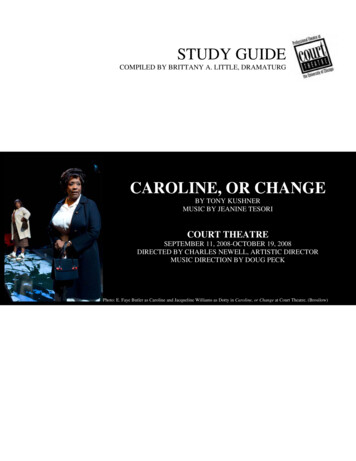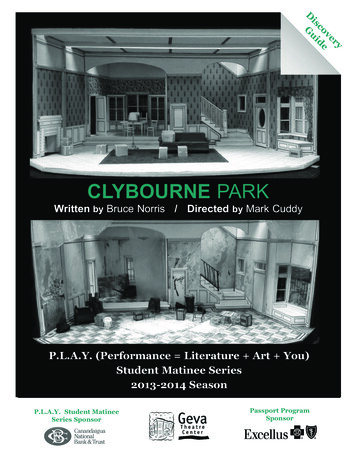
Transcription
ryveco d eis iD GuCLYBOURNE PARKWritten by Bruce Norris / Directed by Mark CuddyP.L.A.Y. (Performance Literature Art You)Student Matinee Series2013-2014 SeasonP.L.A.Y. Student MatineeSeries SponsorPassport ProgramSponsor
1Dear Educators,Table ofContentsAbout ClybournePark . . . . . . . . 2From thePlaywright. . . . 3The RaisinConversation. . 4Confronting theUnfamiliar. . . . 5The Identityof aNeighborhood . 6The Satireof ClybournePark. . . . . . . . 7The Fine Printof PrivateProperty . . . . . 8The ChangingLandscape ofReal Estatein Rochester . . 8When the Set isa Character. . . 9Resources. . . 10Cover images:Scenic designerSkip Mercier’s modelsfor Clybourne Park inAct I (top) andAct II (bottom).One of the lasting effects, for me, of working on a number of AugustWilson’s plays several seasons back is a greater appreciation forwho and what has come before me. As a historian by training and adramaturg by practice, I was always aware of the importance ofprecedence, but now I try to take a little more time to acknowledgethe street or building named after a person, for example – he or shemust have done something of some importance in order to earn sucha distinction. It deserves, at the very least, my passing respect.And so it is with neighborhoods, too. They were not always as theyare now – they had a history. And another history before that. Suchis the story with Clybourne Park, as one group of people gives wayto another and the story of the area changes These stories are allaround us. Several years ago, I owned a house in the South Wedgearea of Rochester. In living there for a decade, I came to understandthat it had only recently emerged from a period of crime, blight, anddepression, and was just beginning a new chapter in its longhistory. I am about to begin work as a dramaturg on a story set, inpart, in the Corn Hill district and will, no doubt, learn more aboutthe area than I could have ever imagined.Your students, though they may argue otherwise, are steeped inhistory, whether they are surrounded by houses built in the 1800s orlive in a brand-new subdivision. Every neighborhood is ClybournePark in one way or another. We just need to make the effort todiscover how and why.Thank you for deciding to bring your students to see ClybournePark. It will, we’re sure, be an experience that they’ll remember fora very long time.Sincerely,Eric EvansEducation Administratoreevans@gevatheatre.org(585) 420-2035Participation in this production and supplementalactivities suggested in this guide support thefollowing NYS Learning Standards:A: 2, 3, 4; ELA: 1, 2, 3, 4; SS: 1, 2, 3, 4“But that’s nice, isn’t it, in a way?To know that we all have our place.” – BevWARNING:Strong languageand maturesubject matter.Approachingcontemporaryissues of race,class andcommunitythrough satire iscomplicated andintentionallyprovocative.Clybourne Parkencouragesaudience membersto questionsocietal attitudesand examinetheir own positionsand actionsthrough a styleof humor thatcan be bothunsettling anduncomfortable.It is highlyrecommendedthat all educatorstake theopportunity toread the scriptof ClybournePark prior toattending withtheir students.If you havequestions orconcerns aboutthe content ofthe play or wouldlike to requestan electronicreading copy,please do nothesitate tocontact theeducationdepartment.
About Clybourne Park2About: Clybourne Park, by Bruce Norris, premiered at Playwrights’ Horizons in 2010, earned the 2011 Pulitzer Prizefor Drama, Laurence Olivier Prize for Best New Play, and the 2012 Tony Award for Best Play.Setting: Clybourne Park is a fictional neighborhoodlocated in central Chicago. The first act is set in 1959; sixyears after the end of the Korean War. The second act isset in the same neighborhood, 50 years later in 2009, witha new generation of residents.Synopsis: In 1959 white, middle-class Clybourne Parkresidents Russ and Bev, who lost their son Kenneth afterhis return home from the Korean War, are planning to selltheir home when their neighbor, Karl, makes anunexpected visit to inform them that the family who isbuying the house is black and that he is attemptingto discourage the black family from moving into theneighborhood. In the same home, 50 years later,Clybourne Park has become a mostly black neighborhood. A white couple, Steve and Lindsey, are planning tobuy the house, tear it down, and replace it with a newhome, forcing a meeting to negotiate local housingregulations with Kevin and Lena, a black couple living inthe area who have historic ties to the home.Characters: “It was very important to me to depict thepeople in 1959 as people with good intentions. They’renot racists in the KKK way — they’re people who thinkthat they’re doing the right thing to protect theirneighborhood and their children and their real estatevalues. But that’s a form of self-interest that has, as itsunfortunate byproduct, a really racist outcome.”– Bruce Norris, Playwright“We see two generations of white Americans struggle tosquare their self-images as decent, thoughtful people withthe reality of their social and economic power over theirAfrican American servants, would-be friends, andpotential neighbors. ‘Are our liberal ideals sustainableoutside the safety of the middle-class, suburban bubble?’Norris forces us to ask ourselves.” – Beryl Satter,Historian“One essential character in the play is the house itself. In1959 this modest, three-bedroom bungalow is neat andwell-maintained. By 2009, it exhibits an overallshabbiness with crumbling plaster and deteriorateddoorways. What happened? We know that it shifted fromwhite to black ownership. Can this alone explain thebuilding’s demise?” – Beryl Satter, Historian u“But you can’t live in a principle, can you?Gotta live in a house.” – Karl
3From the PlaywrightBruce Norris began his career as an actor, but committed himself to playwriting in the late 1990s.Norris is cited as a playwright with a “penchant for sparking arguments” and a reputation for“prodding the uncomfortable truths that lie just beneath the surface of the self-aware,middle-lass liberal” while writing “daring and irreverent plays.” Below, Norris shares his ownthoughts about theatre and Clybourne Park. uAbove:Bruce Norris“Art is the lie that tells thetruth,” said Pablo Picasso.Discuss the meaning of thisquotation as it pertains toClybourne Park, whichemploys fictional charactersto address real issues suchas race, gender, class, andthe intricacies of communnity.Is there a placefor racially-basedjokes in contemporarysociety? Can theybe constructive, asa release valve fora tense situation,for example?Do they hinderconversations orcan they beuseful as well?“Some change is inevitable, and we all support that, but it might be worthasking yourself who exactly is responsible for that change.” – Lena
The Raisin Conversation4The Integration Climate of the 1950sLorraine Hansberrywas born in 1930in Chicago, Illinois.Raised by sociallyconscious parents,she was heavilyinvolved in theCivil Rights movement for most ofher life. Her familymoved in to an allwhite neighborhood when she wasa child and weremet with violentresistance byresidents of thearea. She is bestknown for herplay A Raisin inthe Sun, thestory of a blackfamily in Chicagostruggling to leavetheir dilapidatedapartment behindand move to anall-white neighborhood. The playopened on Broadway in 1959 togreat success.Hansberry was thefirst black playwright to have aplay produced onBroadway and theyoungest AfricanAmerican to win aNew York Critics’Circle award.In the 1940s, attacks such as arson, bombing, and stoning against homes sold to blackfamilies in previously white neighborhoods reached highs similar to those of the early 1920s.Some historians hypothesize that working-class white families of this time thought AfricanAmericans were being given things, like nice homes or financial security, that they hadworked for, which resulted in extreme responses. In any case, black families beginning tooccupy white neighborhoods faced danger, fear, harassment, and destruction, often on adaily basis, as they attempted to secure a better life for themselves and their families. Thesesituations, in conjunction with other major Civil Rights events of the 1950s, such as themurder of Emmett Till, Brown v. Board of Education, the Montgomery Bus Boycott, theLittle Rock High School integration crisis, and the speeches of Dr. Martin Luther King Jr.,made for much turbulence in the years leading up to the sale of the Clybourne Park home tothe Younger family.The relationship between A Raisin in the Sun and Clybourne Park“I saw A Raisin in the Sun as a film in 7th grade. Interestingly, our social studies teacherwas showing it to a class of all-white students who lived in an independent school districtthat was formed specifically to prevent us from being bused to schools with black students.She was showing us a movie that basically, in the end, is really pointing a finger at usand saying, we are those people. So, I watch it at twelve years old and I could realize, eventhen, that I’m Karl Lindner – the white man who comes to ask the Youngers not to moveinto Clybourne Park. To see that when you’re a kid and to realize that you’re the villain hasan impact. It percolated for many years and that’s how I ended up writing this play.I’ve always been fond of A Raisin in the Sun and I thought about how interesting itwould be to tell the story from the point of view of the white neighborhood. Andwhat’s particularly relevant is if you bring it full circle and ask how has that changed orevolved - or not - today.” – Bruce NorrisThe Continuing Influence of A Raisin in the SunWith A Raisin in the Sun, Lorraine Hansberry energized the conversation about howAmericans live together across lines of race and difference. In recent years, severalplaywrights have sought engagement with Hansberry’s story – often through charactersfrom A Raisin in the Sun – and illuminated the tensions and anxieties that still surroundneighborhood integration. Although the plays—Kwame Kwei-Armah’s Beneatha’s Place,Robert O’Hara’s Etiquette of Vigilance, Gloria Bond Clunie’s Living Green, BrandenJacobs-Jenkins’ Neighbors, and Bruce Norris’s Clybourne Park—are distinct from oneanother in terms of style and perspective on their predecessor, they commonly featurecharacters who are forced to closely examine, and sometimes revise or abandon, their ideasconcerning race and their notions of social and economic justice. Above all, the plays use thelenses of neighborliness, privacy, and community to engage the large question of America’scommon purpose.u“Now, Russ: You know as well as I do thatthis is a progressive community.” – Karl
5Confronting the UnfamiliarIn Clybourne Park, a number of provocative issues are addressed, includingdiscrimination, community, stereotypes, and political correctness. Racism is not the onlyform of discrimination that flares in Clybourne Park. Though other means ofdiscrimination are not quite as verbally “called out” in the script, classism, sexism, andableism also come into question.“Steve and Lindsey imagine they’re very close to Kevin and Lena,” commented playwrightBruce Norris. “They think, ‘We’re just the same: They are in our same age group, sameprofessional level, and they seem politically like-minded.’ They make all these assumptionsand yet, from Kevin and Lena’s point of view, there is no illusion that they are the same. Theone person in the second act whom everyone agrees is not the same is Dan. The guy digsditches for a living, so no one pays attention to him.” Dan belongs to a different class ofpeople. Nobody mentions it, but his working-class status in a room full of middle-classpeople stands out.In addition to racial and class differences, there are several other situations where thesecharacters must confront someone unfamiliar or different from themselves – often whilebutting up against a stereotype or generalization of who that person is. Jim, a reverend, isof a religious order. Russ is dealing with deep, grasping grief and depression, Betsy is deaf,and Russ and Bev’s son Kenneth, a Korean War vet, struggled with depression, guilt,anxiety, and what we now know as Post Traumatic Stress Disorder.According to the dramaturgical packet, “During the Korean War (1950-1953), the U.S.’s goalwas to get the communists out of South Korea and prevent other countries from falling tocommunism. Though the war was relatively short, it was also exceptionally bloody andU.S. troops acted under a ‘shoot first, ask questions later’ policy against civilians. Also ofnote, racial integration efforts in the U.S. military began during the Korean War, whereAfrican Americans fought in integrated units for the first time.” When Korean War soldiersreturned home, it wasn’t a clear victory in the minds of many people. The combat was noteven officially recognized as a war until 1998. The horrors lived by these soldiers were,quite often, hardly acknowledged by the communities they returned to, and soveterans, who were already struggling emotionally, further struggled to integrate back intocommunities that never acknowledged or supported them.In this way, the responsibility of a community to its members is adominant component in Clybourne Park. Had the communitytreated Kenneth differently after his return from the war, would hisstory have had a different outcome? What responsibility did theClybourne Park community neighborhood association have tosupport or isolate Russ and Bev in their selling decision, accept ordismiss the Younger family, or protect the values of Karl and Betsy,Russ and Bev, Kevin and Lena, or Lindsey and Steve?Of Betsy’s deafness, Norris says, “The first thing I’ll say is that deafis funny. But it’s not the deaf woman herself that is funny, or herdeafness that’s funny. It’s everyone around her and how they treat her and act towards herthat’s funny. And it makes it clear how awful everyone is around race, that there is this falsecare taken towa
Clybourne Park has become a mostly black neighbor-hood. A white couple, Steve and Lindsey, are planning to buy the house, tear it down, and replace it with a new home, forcing a meeting to negotiate local housing regulations with Kevin and Lena, a black couple living in the area who have historic ties to the home. Characters: “It was very important to me to depict the people in 1959 as .
